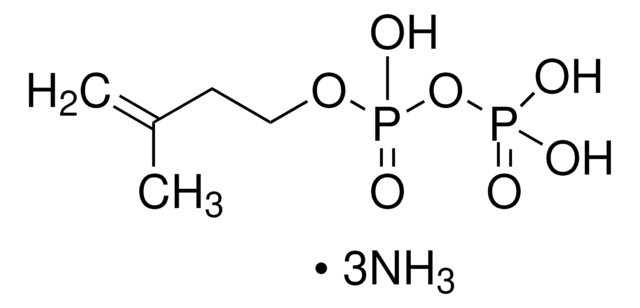Alle Fotos(2)
Wichtige Dokumente
MAK168
Pyrophosphate Assay Kit
sufficient for 200 fluorometric tests (Blue fluorescence)
Synonym(e):
High-Sensitivity Pyrophosphate Assay Kit
Anmeldenzur Ansicht organisationsspezifischer und vertraglich vereinbarter Preise
Alle Fotos(2)
About This Item
Empfohlene Produkte
Verwendung
sufficient for 200 fluorometric tests (Blue fluorescence)
Anwendung(en)
cosmetics
food and beverages
Nachweisverfahren
fluorometric
Lagertemp.
−20°C
Allgemeine Beschreibung
Pyrophosphate (PPi) is produced by a number of biochemical reactions such as ATP hydrolysis, DNA and RNA polymerizations, cyclic AMP formation, and the formation of fatty acid-coenzyme A esters. It is hydrolyzed by inorganic pyrophosphatase. PPi is present in the blood and in the extracellular matrix of tissues.
Eignung
The Pyrophosphate Assay Kit provides a simple and direct microplate assay procedure for measuring pyrophosphate in a variety of samples.
Prinzip
The pyrophosphate concentration of a sample is determined by the use of a unique fluorogenic pyrophosphate sensor in which the presence of pyrophosphate results in the production of a fluorescent product (λex =316/λem = 456 nm) proportional to the pyrophosphate present. This assay is simpler and more robust than traditional enzyme-based methods and is ideal for screening enzyme activity or enzyme inhibitors.
Signalwort
Danger
H-Sätze
P-Sätze
Gefahreneinstufungen
Eye Dam. 1
Lagerklassenschlüssel
10 - Combustible liquids
WGK
WGK 3
Flammpunkt (°F)
188.6 °F
Flammpunkt (°C)
87 °C
Hier finden Sie alle aktuellen Versionen:
Analysenzertifikate (COA)
Lot/Batch Number
Die passende Version wird nicht angezeigt?
Wenn Sie eine bestimmte Version benötigen, können Sie anhand der Lot- oder Chargennummer nach einem spezifischen Zertifikat suchen.
Besitzen Sie dieses Produkt bereits?
In der Dokumentenbibliothek finden Sie die Dokumentation zu den Produkten, die Sie kürzlich erworben haben.
Kunden haben sich ebenfalls angesehen
Jithesh Kottur et al.
Nucleic acids research, 46(12), 5875-5885 (2018-06-01)
DNA synthesis by DNA polymerases (dPols) is central to duplication and maintenance of the genome in all living organisms. dPols catalyze the formation of a phosphodiester bond between the incoming deoxynucleoside triphosphate and the terminal primer nucleotide with the release
Peiyi Zheng et al.
Journal of molecular biology, 431(4), 764-776 (2019-01-18)
Phosphopantothenoylcysteine (PPC) synthetase (PPCS) catalyzes nucleoside triphosphate-dependent condensation reaction between 4'-phosphopantothenate (PPA) and l-cysteine to form PPC in CoA biosynthesis. The catalytic mechanism of PPCS has not been resolved yet. Coenzyme A biosynthesis protein 2 (Cab2) possesses activity of PPCS
Pyrophosphate hydrolysis is an intrinsic and critical step of the DNA synthesis reaction.
Kottur J and Deepak T N
Nucleic Acids Research (2018)
Tyler M Weaver et al.
Proceedings of the National Academy of Sciences of the United States of America, 117(41), 25494-25504 (2020-10-02)
During DNA replication, replicative DNA polymerases may encounter DNA lesions, which can stall replication forks. One way to prevent replication fork stalling is through the recruitment of specialized translesion synthesis (TLS) polymerases that have evolved to incorporate nucleotides opposite DNA
Young-Joo Yi et al.
PloS one, 7(4), e34524-e34524 (2012-04-10)
Inorganic pyrophosphate (PPi) is generated by ATP hydrolysis in the cells and also present in extracellular matrix, cartilage and bodily fluids. Fueling an alternative pathway for energy production in cells, PPi is hydrolyzed by inorganic pyrophosphatase (PPA1) in a highly
Unser Team von Wissenschaftlern verfügt über Erfahrung in allen Forschungsbereichen einschließlich Life Science, Materialwissenschaften, chemischer Synthese, Chromatographie, Analytik und vielen mehr..
Setzen Sie sich mit dem technischen Dienst in Verbindung.








